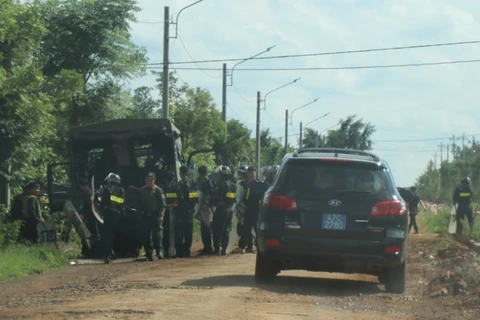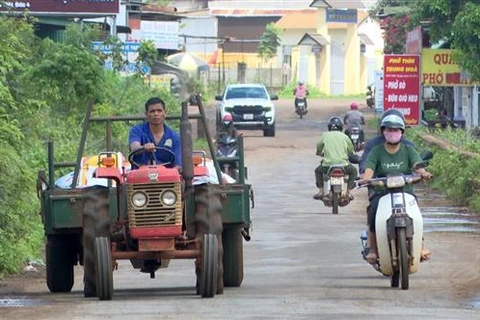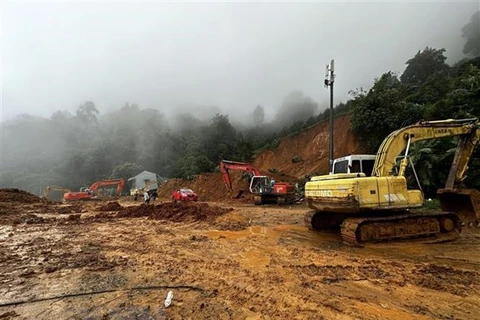
Hanoi (VNA) – The Central Highlands, home to nearly 6 million people, needs thorough solutions to issues related to land use, agro-forestry-fisheries development, and ecological environment protection in order to deal with risks of instability in security and order.
Despite its great development potential, the region has still struggling with many socio-economic difficulties and challenges, especially land-related problems.
Many local residents are short of farming land, while production land area is shrinking due to degradation of soil quality, inefficient land use, land dispute, encroachment, or speculation. This is one of the main causes of poverty, deforestation and risks of security and order instability in the region.
Recently, a terrorist attack at the administration, causing a particularly serious insecurity and disorder in Dak Lak province. Initial investigation results showed that hostile forces, supported by FULRO elements living in exile in the US, incited locals on the cyberspace and divided people from the Kinh ethnic group and other ethnic minority groups under the cover of claiming land.
Settling land-related problems will not only solve the problem in local residents’ livelihood, but also tackle potential risk to security and order.
The region’s renovation and progress today is a result of the joint efforts of the Party, administration and local residents. Dak Lak has become the country’s coffee production hub, while Da Lat city in Lam Dong province has become a famous tourism destination and the largest vegetable and flower hub of the country, and Gia Lai is a land of peppercorn and rubber.

The Central Highlands has 3.2 million hectares of forest land, accounting for 21% of the country’s total, along with 1 million hectares of red basaltic soil area, 1.8 million hectares of Feralit red yellow soil area, as well as a diverse ecosystem and favourable weather conditions. It boasts great potential in energy industry development and rich natural resources, and is also home to many precious herbal plants such as Ngoc Linh ginseng, while owning plenty of advantages to become a major tourism centre of the country.
In order to boost the region’s growth, including agro-forestry development, it is crucial to cope with basic issues related to land. The situation of land disputes has seriously affected rural security, becoming a weakness for hostile forces to take advantage of for disruptive incitement.
Secretary of the Party Committee of Dak Lak Nguyen Dinh Trung pointed to the need for clearer mechanisms and policies for the management of land, especially forestry land in the Central Highlands. At the same time, it is necessary to clarify the management of forest and forest land as well as the switching of inefficient forest land into farming land, he said, stressing the need for mechanisms and policies to harmoniously settle the relations between forestry and agriculture in order to deal with land-related problems in the region.
Agriculture has played an important role in the development of the region, not only in the socio-economic aspects but also in terms of politics, security and defence. In other words, agriculture, farmers and rural areas are the foundation and strength for the region to improve locals’ living conditions and develop itself in a sustainable manner.
According to Trung, over the years, despite modest State budget collection, regional localities have designed various policies to support local people. They have paid great attention to renovating production methods by ethnic minority groups in the region, creating necessary conditions for them to access land and farming techniques and form cooperatives and cooperative groups to promote production, while encouraging local residents to change their mindset and inspire their desire to improve their material and spiritual living conditions.

Thanks to the issuance of the 9th Politburo’s Resolution 10-NQ/TW on promoting socio-economic development and ensuring security and defence in the Central Highlands, resources invested into the strategic region have increased, supporting its sustainable development.
The 13th-tenure Politburo has also issued a resolution to make a push for the region to develop green, circular and national cultural identity-imbued economy.
Chairman of the National Assembly’s Committee for Ethnic Minority Affairs Y Thanh Ha Nie KDam said stability and development of ethnic minority-inhabited areas is an important factor for the growth of the Central Highlands, and the foundation for the building of the great national solidarity bloc. Therefore, it is necessary to design proper mechanisms and solutions to improve the living conditions of the local ethnic minority communities, while paying greater attention to the specificity, psychological characteristics, customs and habits of local residents when solving specific problems in the region, he emphasised./.























